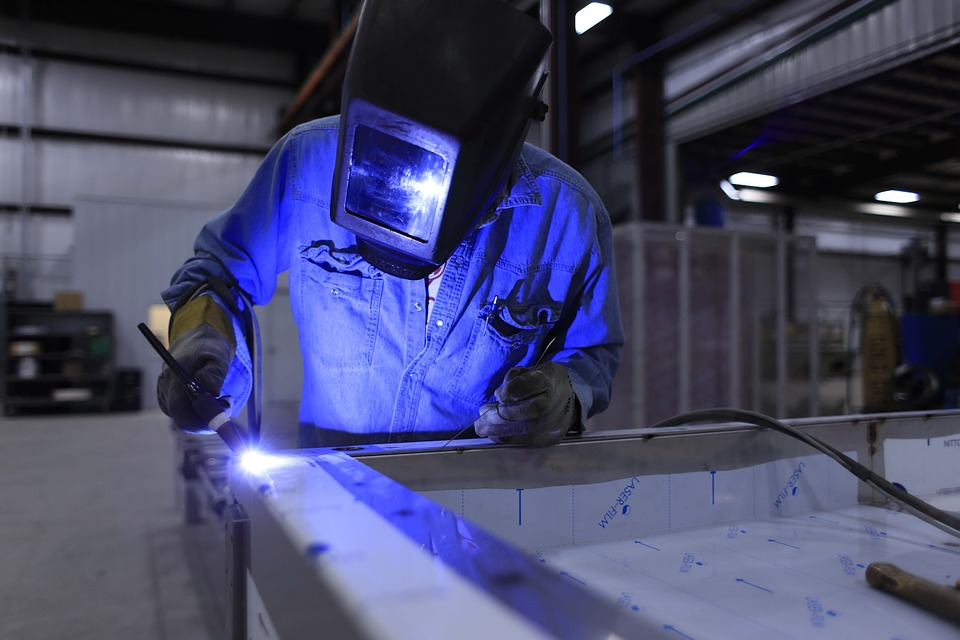Welding managers seeking to work more efficiently are reviewing their entire process, which includes pneumatic tools, such as grinders.
Combining Ergonomics with Safety to Increase Productivity
The Importance of Ergonomics
When considering the ergonomics of the tool, there are numerous questions operators should ask themselves. How comfortable and easy are the tools to handle and use? How long are the tools expected to be used for at any given time? What are the vibration levels like?
Tools that have been designed properly with the operator in mind undoubtedly offer higher levels of comfort, which means they can get the job done more quickly, thus being more productive.
An ergonomic design is crucial for ensuring tools are comfortable to use and can be handled easily. Ergonomic factors to keep in mind in the design of the tool include visibility of the operation, noise and vibration, handles and grips, and weight.
Visibility
When the CP3850 grinder was designed by Chicago Pneumatic, they wanted to make sure the tool had a low and lean profile so operators could better see what they are working on. Grinders typically tend to be bulky, and while an operator can still see the tip, more can be seen with this new range of grinders. This design is not needed to comply with CE or ISO standards, but it is an additional benefit to users, increasing their visibility of the abrasive and the job in hand.
Noise and Vibration
The grinder has been designed with an auto-balancer as well. An auto-balancer plays a significant role in removing the imperfections of the disc the operator is using, which makes it vibration or reaction free. This makes it much more comfortable to use and, therefore, operators can remove more material with less vibration.
Welders also realize the advantages of increased productivity as the number of discs used per year can be reduced. Since the discs are vibrating less, it allows an equal use of the abrasive, which results in more material removed with one disc, and in a lower number of discs used.
Handles and Grips
While side handles positioned in the right place offer support, they are also designed to absorb energy, providing added value for the user. Furthermore, some tools feature adjustable side handles that can be tilted to fit every operators’ preference.
Materials utilized on the tools also play an important role in ergonomics. For instance, the latest tools have composite handles, which means they are warmer to hold than metal handles and are lighter.
Weight
How powerful does the tool need to be for the application? Tools that are more powerful tend to be heavier, which can be more difficult for users to operate. However, the latest designs mean there are now tools that deliver excellent power-to-weight rations, meaning they provide high performance but are easier to use. Operators will be able to hold the tool for longer periods of time without excessive strain, allowing them to get the job done in a quicker and more qualitative way.
When specifying tools, ergonomics should not be the only factor to consider. Safety is just as important.
Why Safety is Important
Safety is paramount in every industry and protecting the operators should be a priority for any metalworking application. As a result, it is essential to consider the safety features of the tool and the tests it has gone through to ensure it provides maximum safety levels. Selecting angle grinders that have protective guards and are proven to withstand the force should the grinding wheel burst, are essential. Additionally, metalworkers should check whether the tool complies with CE, ISO and other international standards.
Safety standards in the U.S. for workplace equipment are set by the Occupational Safety & Health Administration (OSHA). OSHA recommends maximum working noise levels as well. The Threshold Limit Values (TLVs) and guidelines recommended by the American Conference of Governmental Industrial Hygienists (ACGIH) are often also used. These TLVs are based on recommendations in the standards, and manufacturers should follow standard testing procedures for measuring noise and vibration levels.
Controlling Noise and Vibration
Noise and vibration are important to consider because if a pneumatic tool is too loud, it can cause long-term damage to an operator’s hearing or, if it vibrates at a high level, it can cause strain and injury. According to the Canadian Centre for Occupation Health and Safety (CCOHS), vibration-induced health conditions progress slowly. It starts as a pain, but as the vibration exposure continues, the pain may develop into an injury or disease.
The most common condition found in operators of vibrating, handheld tools is vibration-induced white finger (VWF). Vibration can cause changes in tendons, muscles, bones and joints, plus affect the nervous system. Collectively, these effects are known as Hand-Arm Vibration Sydrom (HAVS). The symptoms of VWF are aggravated when the hands are exposed to cold.
In addition to the standard ISO tests, reliable manufacturers also invest in test procedures that go far beyond those requirements. For instance, there is no standard for a grinder’s drop test, but some manufacturers have identified this as being vital to ensuring the tools provide the highest levels of safety and durability. In this test, a tool is dropped from a height of 1 m onto a very hard surface. This is done with every product by Chicago Pneumatic and in six different positions and at different temperatures. Tools are dropped in normal temperatures, then placed into a freezer to make them brittle before being dropped again.
Speed and Power
Chicago Pneumatic also conducts a test to define power, and another to test the breaking limits of the grinder guard. Grinders are purposely driven until the abrasive fail, so the guards can be tested for robustness. This test consists of a wooden box where the grinding wheel is made to burst. The variety of projections of the wheel can be seen, and where it has been hit. The pieces have to be located below a reference line, which ensures that the guards are designed to ensure the safety of the user in case of breakage.
It is recommended that to maintain the maximum level of safety, grinder speed should never exceed the maximum operating speed indicated on the abrasive. For example, an 8500-rpm, 7-in. grinding wheel should not be used on a 12,000 rpm grinder.
The Latest Tools and Safety Developments
There are numerous features that have been designed on the latest grinders to make sure they are safe as well as ergonomic.
Optimal Triggers
Safety triggers are included to avoid uncontrolled and unwanted start. This makes sure the disc will only rotate when the user is present and has depressed the trigger.
Safety Guards
Safety guards today are adjustable without a key, and can be oriented according to the working position.
Low Profile
A design is necessary that gives a proper view of the operation so users don’t have to bend over the tool as much and can clearly see the job they are working on.
Auto Balancer
This functions to reduce vibration, which in turn reduces the risk of the abrasive breaking as well as reduces noise.
Which such an extensive range of tools on the market, including grinders, it can be difficult to know where to start when specifying. During the selection process, the ergonomics and safety need to be considered.
The most ergonomically designed tools with composite handles that are well balanced and provide minimum strain to the user mean operators will be able to complete the job with more ease and their productivity will increase. Tools that offer a low profile that maintain good operator visibility are an advantage.
Source: aws.org


